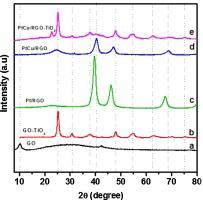当前位置:
X-MOL 学术
›
Synth. Met.
›
论文详情
Our official English website, www.x-mol.net, welcomes your
feedback! (Note: you will need to create a separate account there.)
Bimetallic PtCu-decorated reduced graphene oxide (RGO)-TiO2 nanocomposite for efficient oxygen reduction reaction
Synthetic Metals ( IF 4.0 ) Pub Date : 2020-08-01 , DOI: 10.1016/j.synthmet.2020.116433 B. Sravani , Y. Chandrashekar , P. Sri Chandana , T. Maiyalagan , L. Subramanyam Sarma
Synthetic Metals ( IF 4.0 ) Pub Date : 2020-08-01 , DOI: 10.1016/j.synthmet.2020.116433 B. Sravani , Y. Chandrashekar , P. Sri Chandana , T. Maiyalagan , L. Subramanyam Sarma

|
Abstract To exploit the full advantages of electrocatalysts for fuel cell reactions, a promising support is essential to disperse electrocatalytically active metal nanoparticles. Here, at first a graphene oxide-titanium dioxide composite support (GO-TiO2) is fabricated by a sol–gel method. Later, a facile chemical reduction method is demonstrated to simultaneously reduce Pt4+, Cu2+ and GO-TiO2 to form bimetallic PtCu nanoparticles (15 wt% Pt + 5 wt% Cu) on a reduced graphene oxide-titanium dioxide (RGO-TiO2) composite support. A combined action of ethylene glycol and ascorbic acid play a positive role in attaining well dispersed PtCu with a size of 7 nm particles on RGO-TiO2 sheets. The resulting PtCu/RGO-TiO2 nanocomposite exhibits superior electrode-area normalized ORR limiting current density (6.14 mA/cm2-geo) when compared to commercial Pt/C (3.61 mA/cm2-geo) and in-house synthesized PtCu/RGO (4.68 mA/cm2-geo) and Pt/RGO (3.95 mA/cm2-geo) catalysts. The synthesized catalysts are characterized for structural, morphological and surface elemental features by using a combination of diffraction, spectroscopy and electron microscopy techniques. The positive role played by PtCu and RGO-TiO2 composite support assists the improved ORR activity. The versatile synthesis methodology presented here is convenient to fabricate other similar electrocatalytic nanostructures for fuel cell reactions.
中文翻译:

双金属 PtCu 装饰的还原氧化石墨烯 (RGO)-TiO2 纳米复合材料用于有效的氧还原反应
摘要 为了充分利用电催化剂在燃料电池反应中的优势,分散具有电催化活性的金属纳米颗粒至关重要。在这里,首先通过溶胶-凝胶法制备氧化石墨烯-二氧化钛复合载体(GO-TiO2)。后来,证明了一种简便的化学还原方法可以同时还原 Pt4+、Cu2+ 和 GO-TiO2,在还原的氧化石墨烯-二氧化钛 (RGO-TiO2) 复合载体上形成双金属 PtCu 纳米颗粒(15 wt% Pt + 5 wt% Cu) . 乙二醇和抗坏血酸的联合作用对于在 RGO-TiO2 片上获得 7 nm 颗粒大小的良好分散的 PtCu 起到积极作用。所得的 PtCu/RGO-TiO2 纳米复合材料表现出优异的电极面积归一化 ORR 限制电流密度 (6. 14 mA/cm2-geo) 与商业 Pt/C (3.61 mA/cm2-geo) 和内部合成的 PtCu/RGO (4.68 mA/cm2-geo) 和 Pt/RGO (3.95 mA/cm2-geo) 相比催化剂。通过结合使用衍射、光谱和电子显微镜技术,对合成的催化剂进行结构、形态和表面元素特征的表征。PtCu 和 RGO-TiO2 复合载体所起的积极作用有助于提高 ORR 活性。这里介绍的通用合成方法便于制造其他类似的用于燃料电池反应的电催化纳米结构。光谱学和电子显微镜技术。PtCu 和 RGO-TiO2 复合载体所起的积极作用有助于提高 ORR 活性。这里介绍的通用合成方法可以方便地制造其他类似的用于燃料电池反应的电催化纳米结构。光谱学和电子显微镜技术。PtCu 和 RGO-TiO2 复合载体所起的积极作用有助于提高 ORR 活性。这里介绍的通用合成方法可以方便地制造其他类似的用于燃料电池反应的电催化纳米结构。
更新日期:2020-08-01
中文翻译:

双金属 PtCu 装饰的还原氧化石墨烯 (RGO)-TiO2 纳米复合材料用于有效的氧还原反应
摘要 为了充分利用电催化剂在燃料电池反应中的优势,分散具有电催化活性的金属纳米颗粒至关重要。在这里,首先通过溶胶-凝胶法制备氧化石墨烯-二氧化钛复合载体(GO-TiO2)。后来,证明了一种简便的化学还原方法可以同时还原 Pt4+、Cu2+ 和 GO-TiO2,在还原的氧化石墨烯-二氧化钛 (RGO-TiO2) 复合载体上形成双金属 PtCu 纳米颗粒(15 wt% Pt + 5 wt% Cu) . 乙二醇和抗坏血酸的联合作用对于在 RGO-TiO2 片上获得 7 nm 颗粒大小的良好分散的 PtCu 起到积极作用。所得的 PtCu/RGO-TiO2 纳米复合材料表现出优异的电极面积归一化 ORR 限制电流密度 (6. 14 mA/cm2-geo) 与商业 Pt/C (3.61 mA/cm2-geo) 和内部合成的 PtCu/RGO (4.68 mA/cm2-geo) 和 Pt/RGO (3.95 mA/cm2-geo) 相比催化剂。通过结合使用衍射、光谱和电子显微镜技术,对合成的催化剂进行结构、形态和表面元素特征的表征。PtCu 和 RGO-TiO2 复合载体所起的积极作用有助于提高 ORR 活性。这里介绍的通用合成方法便于制造其他类似的用于燃料电池反应的电催化纳米结构。光谱学和电子显微镜技术。PtCu 和 RGO-TiO2 复合载体所起的积极作用有助于提高 ORR 活性。这里介绍的通用合成方法可以方便地制造其他类似的用于燃料电池反应的电催化纳米结构。光谱学和电子显微镜技术。PtCu 和 RGO-TiO2 复合载体所起的积极作用有助于提高 ORR 活性。这里介绍的通用合成方法可以方便地制造其他类似的用于燃料电池反应的电催化纳米结构。











































 京公网安备 11010802027423号
京公网安备 11010802027423号